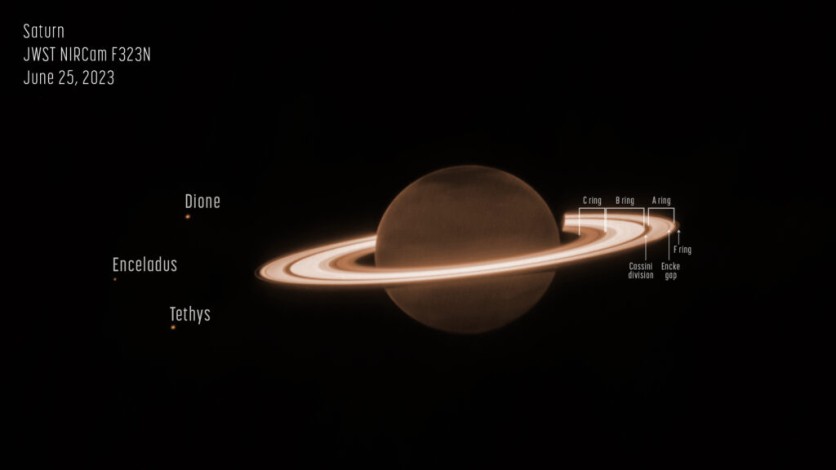NASA's James Webb Space Telescope, renowned for its capabilities in near-infrared observations, recently turned its gaze towards the beautiful ringed planet Saturn.
The initial images captured by the telescope's Near-Infrared Camera (NIRCam) on June 25 have already captivated researchers, offering intriguing insights into Saturn's enigmatic beauty.

NASA's James Webb Space Telescope Captures Icy Rings Glow in Infrared Light
Saturn appears remarkably dark in this particular infrared wavelength due to the absorption of sunlight by methane gas in its atmosphere. However, the icy rings surrounding the planet remain relatively bright, creating a striking and unusual appearance in the Webb image.
This image was obtained as part of Webb's Guaranteed Time Observation program 1247, which involved conducting deep exposures of Saturn. The purpose of these exposures was to test the telescope's capability to detect faint moons and explore the intricate details of Saturn's majestic rings.
Uncovering new moons could provide scientists with valuable information to enhance our understanding of Saturn's present and past configurations. The image of Saturn reveals intricate details within its expansive ring system, showcasing several of its moons, such as Dione, Enceladus, and Tethys.
Several deeper exposures not shown in this image will enable the research team to investigate the planet's fainter rings, including the thin G ring and the diffuse E ring.
Composed of an assortment of rocky and icy fragments, Saturn's rings exhibit a wide range of particle sizes, from tiny grains of sand to mountain-sized objects found on Earth.
Notably, NASA's Webb exploration of Enceladus unveiled a substantial plume emanating from the moon's southern pole, consisting of particles and copious amounts of water vapor, which nourish Saturn's E ring.
Saturn's Atmosphere
The image also provides intriguing insights into Saturn's atmosphere, revealing unexpected levels of detail. While the Cassini spacecraft offered greater clarity in observing the atmosphere, this image from Webb provides a unique perspective at a specific wavelength (3.23 microns) exclusive to the telescope.
The large, dark, and diffuse structures observed in the planet's northern hemisphere do not conform to the lines of latitude, deviating from the familiar striped appearance commonly associated with Saturn's deeper atmospheric layers.
These patchy structures resemble large-scale planetary waves in the high-altitude stratospheric aerosols, akin to those witnessed in earlier NIRCam observations of Jupiter.
For decades, missions such as NASA's Pioneer 11, Voyagers 1 and 2, the Cassini spacecraft, and the Hubble Space Telescope have diligently monitored Saturn's atmosphere and rings.
The observations captured by Webb merely offer a glimpse of the invaluable contributions this observatory will make to Saturn's narrative in the years to come.
As the science team delves deeper into the data and prepares peer-reviewed results, the secrets of Saturn may soon unfold, enriching our understanding of this captivating celestial body.
Related Article : NASA's James Webb Space Telescope Captures Starlight From Massive Black Holes in the Early Universe

![Apple Watch Series 10 [GPS 42mm]](https://d.techtimes.com/en/full/453899/apple-watch-series-10-gps-42mm.jpg?w=184&h=103&f=9fb3c2ea2db928c663d1d2eadbcb3e52)



